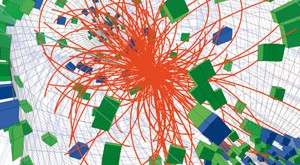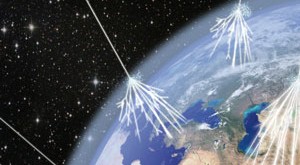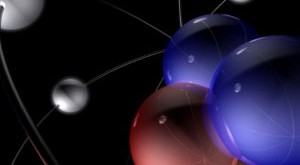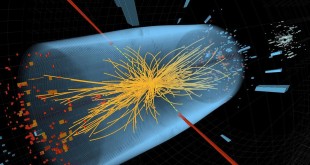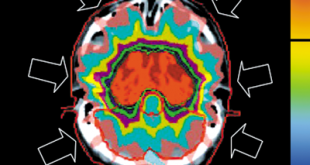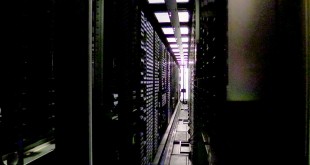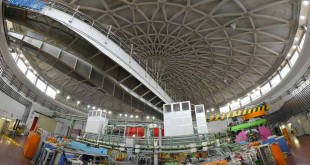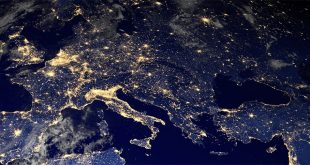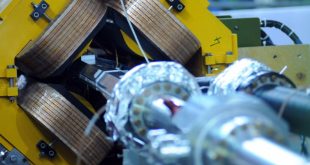The first decades of the 20th century saw intense activity in the study of the structure of the atom. Observation of radioactive decay and interaction of particle beams with matter allowed physicists to make fundamental discoveries. At the same time, thanks to the study of cosmic radiation, it was possible to observe particles until then unknown. Technological development subsequently facilitated the construction of accelerators, machines that increase the energy of the particles making them travel to near the speed of light, the maximum speed possible for any kind of body. The use of accelerators has permitted exploration of the fundamental constituents of atomic nuclei and the creation of new forms of matter. In linear accelerators, particles are made to collide with a fixed target, while in circular accelerators two particle beams accelerated in opposite directions collide with each other. The quantity of energy that the particles have acquired before impact are converted into other forms of matter thanks to the interaction, thus making it possible to observe new particles.
Read More »Research
Astroparticle physics
Astroparticle physics includes a vast field of research with experiments conducted mostly without accelerators on cosmic radiation, neutrinos, gravitation and quantum mechanics. Consequently, also the used experimental techniques are very heterogeneous, ranging from lasers to the use of low activity materials, from cryogenics to the particle detectors used in other lines of research. The experiments may be of small size (“table-top”) or extend over areas of several km2, situated in space or under the sea, in underground laboratories or in the Antarctic ice. The discovery of cosmic radiation dates back to 1912 and for many years, before the use of accelerators, allowed us to discover new hitherto unknown particles (just think of the “positron”, i.e. the anti-electron). Although research in the astroparticle physics field has spanned more than a century, it is still a research sector full of new and exciting discoveries (just think of the recent observation of gravitational waves by the LIGO experiment), in which the National Institute for Nuclear Physics is engaged since decades. In particular, researchers of the Frascati National Laboratories are involved in neutrino studies and in space research. For further information: http://home.infn.it/it/ INFN official website. http://www.asimmetrie.it/ INFN magazine, with a number of monographs on the subject.
Read More »Nuclear physics
The research carried out in the framework of Nuclear Physics is aimed to understand the structure and the dynamics of the matter composing atomic nuclei. In this field, experimental techniques are developed to investigate nuclei in extreme conditions. The experiments conducted with particle accelerators allow to study the mechanisms underlying the working of stars in every phases of their evolution and to recreate in laboratory the extreme conditions of density and temperature of a quark and gluon plasma, a state of matter that we presume have characterized the Universe in the first tenth millions of a second after the Big Bang. The study of collisions between an electron and a nucleus provides a tridimensional picture of the inner part of a nucleus. Moreover the study of nuclear force in presence of “strange” quarks enhances the comprehension of the behavior of neutron stars.
Read More »Theoretical physics
The experiments performed in the Frascati National Laboratories concern the study of the structure of matter, nuclear and sub-nuclear physics, astrophysics and cosmology. As in all the fields of physics, also in these fields experimental and theoretical research go hand in hand, complementing each other and helping to establish jointly a set of new knowledge. Experimental results, sometimes unexpected and surprising, need to be understood within the context of consistent and predictive theories, which should be as complete as possible. In turn, these theories lead to the prediction of new phenomena, which must be subjected experimental verification in order to ascertain the effective validity of the particular theories they stem from. With the advancement of knowledge and the increasing levels of complexity achieved by physical theories, these verifications require increasingly complex challenges, and it is not uncommon that several decades can elapse between the formulation of theoretical predictions and the corresponding experimental verifications. A recent example is the discovery of the Higgs boson, whose existence was first postulated around 1964 and whose actual discovery required almost 50 years, until the joint announcement of 14 July 2012, when the two experimental collaborations ATLAS and CMS at CERN in Geneva confirmed the discovery of a new particle with a mass of approx. 125 times the mass of the proton, and with characteristics compatible (within the margins of experimental error) with those predicted by the theory for the Higgs boson. Another very recent example concerns the detection of gravitational waves, whose existence was predicted in 1916 by Albert Einstein as …
Read More »Technological research
The construction of new particle accelerators and detectors requires continuous development of increasingly advanced technologies in various application fields of electronics, computing and computer networks. The Frascati National Laboratories are engaged in numerous projects involving the development of new accelerators, detectors and in other interdisciplinary fields. Developments in advanced technological research in nuclear and sub-nuclear physics involve various fields of public interest and primarily medicine and the arts. The need to create accelerator machines with characteristics allowing the study of the most intimate properties of matter, has stimulated the development of superconducting technologies and highly advanced mechanics in order to implement accelerator cavities and superconducting magnets and cables. The main application of superconducting magnets in particle accelerators is the implementation of dipoles curving the charged particle beam as effectively and in the shortest space possible. This requires magnetic field intensity and rate of increase of the same impossible to obtain without superconducting technologies. In future accelerators, moreover, the high beam intensity required, together with its extremely small size, also requires development of analysis of the materials with which the accelerators themselves are made and of the surfaces in contact with the circulating beam. The LNF are at the forefront in this type of materials science and surface physics technological research in connection with accelerator physics, having not only specific expertise in the various fields, but also the possibility of using Synchrotron Light radiation emitted by Dafne. Of great interest for recent linear accelerator studies and applications is the research and development …
Read More »Computing
Kloe-2 scientific computing, Tier2 and the Computing Service of the National Laboratory of Frascati.
Read More »Accelerators physics
INFN and particularly the Frascati National Laboratories have been and continue to be involved in the development of new accelerators.
Read More »External funds
Research projects at The National Laboratories of Frascati (LNF) are funded by public and private entities: European Commission (FP4, FP5, FP6, FP7 and Horizon 2020), MIUR, MAECI (high importance projects in bilateral agreements with extra-Eu countries), MISE (Industry 2015, FIT, Industry 4.0), Regione Lazio and Regione Calabria (POR – FSE), NATO, ESA, ASI, Ospedale Pediatrico Bambin Gesù, Silicon Valley Foundation (USA), John Templeton Foundation (USA).
Read More »Knowledge Valorization Service
The Knowledge Valorization Service operates on three majos areas: in close collaboration with the following figures: External funds referent; Training referents (institutional); Technology Transfer referents (institutional) The Service is composed of a service manager, Claudio Gatti; Giuliano Basso, web solutions manager; Daniela Ferrucci, support, coordination and organization of the Service.
Read More »Technological Transfer
Our Technological Transfer staff focuses on strengthening the relationship between the research world and industry through support actions aimed at effectively connecting innovation and business.
Read More » INFN-LNF Laboratori Nazionali di Frascati
INFN-LNF Laboratori Nazionali di Frascati
